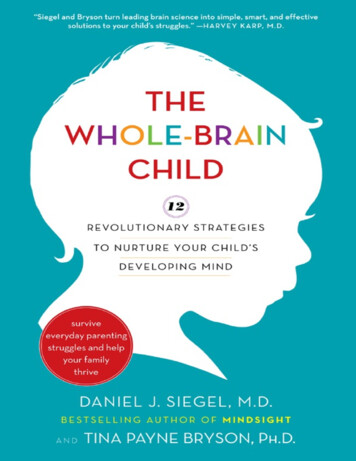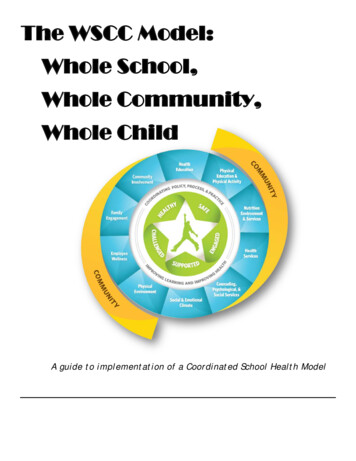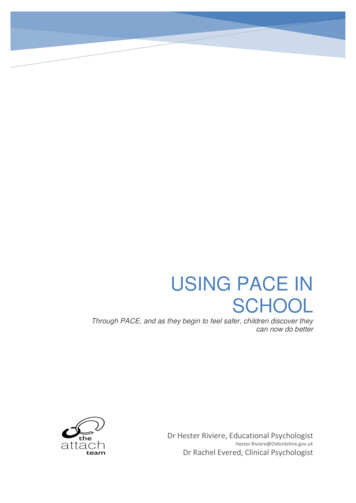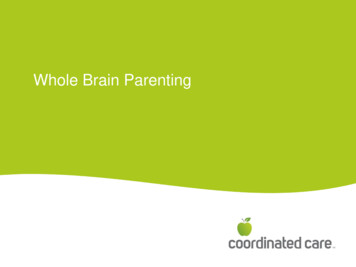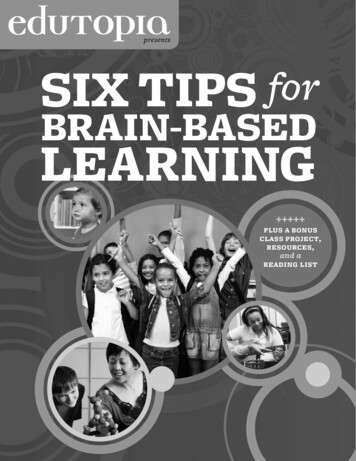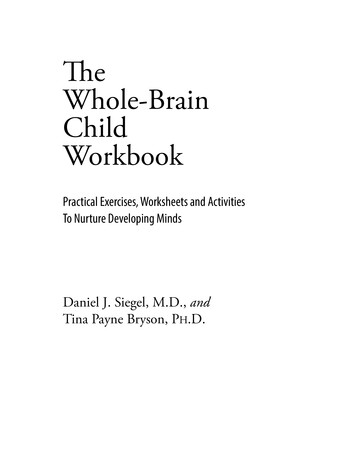
Transcription
TheWhole-BrainChildWorkbookPractical Exercises, Worksheets and ActivitiesTo Nurture Developing MindsDaniel J. Siegel, M.D., andTina Payne Bryson, PH.D.
Copyright 2015 by Mind Your Brain, Inc, and Tina Payne Bryson, Inc.All rights reserved.Published byPESI Publishing & Media3839 White AveEau Claire, WI 54703Printed in the United States of AmericaISBN: 978-1-9361287-4-7Library of Congress Cataloging-in-Publication DataSiegel, Daniel J., 1957The whole-brain child workbook : practical exercises, worksheets and activities to nurturedeveloping minds / Daniel J. Siegel, M.D. & Tina Payne Bryson, Ph.D.pages cmISBN 978-1-936128-74-7 (alk. paper) 1. Parenting. 2. Child development. 3. Childpsychology. 4. Child rearing. I. Bryson, Tina Payne. II. Title.HQ755.8.S53275 2015306.874--dc232015000374Illustrations by Tuesday MourningLayout Design: Matt PabichCover Design: Amy RubenzerPESIPublishing& Mediawww.pesipublishing.com
ContentsA message from Dan and Tina 5CHAPTER 1Parenting With The Brain In Mind 7CHAPTER 2Two Brains are Better Than One 13Whole-Brain Strategy #1: Connect And RedirectWhole-Brain Strategy #2: Name It to Tame ItCHAPTER 3Building The Staircase of The MindIntegrating the Upstairs and Downstairs Brain 35Whole-Brain Strategy #3: Engage Don’t EnrageWhole-Brain Strategy #4: Use It or Lose ItWhole-Brain Strategy #5: Move It Or Lose ItCHAPTER 4Kill the ButterfliesIntegrating Memory for Growth and Healing 61Whole-Brain Strategy #6: Use the Remote of the MindWhole-Brain Strategy #7: Remember to RememberCHAPTER 5The United States of MeIntegrating The Many Parts of Self 83Whole-Brain Strategy #8: Let the Clouds of Emotion Roll ByWhole-Brain Strategy #9: SIFT – What’s Going On InsideWhole-Brain Strategy #10: Exercising Mindsight: Getting Back to the HubCHAPTER 6The Me-We Connection:Integrating Self and Other 109Whole-Brain Strategy #11: Increase the Family Fun Factory – Making a Point to Enjoy Each OtherWhole-Brain Strategy #12: Connection Through Conflict – Teach Kids to Argue with a “We” in MindCONCLUSIONBringing It All Together 133ACKNOWLEDGMENTS 135ABOUT THE AUTHORS 136
A MESSAGE FROM DAN AND TINA:We want to express our profound admiration that you’ve decided to even open this book. We’reboth parents, so we know how hard it is sometimes just to get through a day, much less read a book aboutparenting. And now, you’ve decided not only to read a book about parenting, but to explore a workbookabout a book about parenting! We greatly respect the commitment you’re making to nurture your childrenand the health of your family—as well as yourself.We’ve written this workbook for you: the busy, possibly overwhelmed but still committed parentwho wants to understand at an even deeper level what it means to connect with your children. Maybeyou’re reading it on your own, or as a part of a group. Maybe you’re not even technically a parent, butyou want to better understand and relate to the kids you care about. Maybe you are a parent educatorand you’re using this book to lead a group to greater insight and application of the Whole-Brain approach.Whatever your situation, this workbook is for you.In the following pages, where we ask you to write, we ask for only a few lines’ worth. (You canof course write more if you’d like.) Writing things down is a proven way to deepen and broaden yourunderstanding, and it’s a great way to make sense of what you’ve been doing and how you might considerdoing things even better. We’ve given you various activities you can do on your own and/or with your kids,but these are absolutely optional. We’ve written the workbook so that each chapter builds on the previousone, but it’s fine to skip around.In other words, there are no absolute rules here. This isn’t an additional obligation hanging overyour head, or something for you to feel guilty about not doing on a regular basis, or not doing well enough.This workbook is simply a way for you to find more help and support to do what you want to do anyway:move towards a deeper understanding of and connection with your children, and a fuller understanding ofyourself as a parent.Thanks for letting us be a part of your journey.Dan and Tina
CHAPTER 1Parenting With The Brain In MindWe aren’t held captive for the rest of our lives by the way thebrain works at this moment – we can actually rewire it so thatwe can be healthier and happier. This is true not onlyfor children and adolescents, but also for eachof us across the life span.– The Whole-Brain ChildIn the Introduction to The Whole-Brain Child, we discuss the two goals that practically all parents share. Thefirst, most immediate objective, is simply to survive the countless challenging moments we face throughoutthe day as we interact with our children. Sometimes it feels like that’s all we can hope for: to simply survive.But of course, we want to aim for more than mere survival. We also want our kids to thrive. We wantto give them experiences that help them become better human beings, who know what it means to love andtrust, to be responsible, to be resilient during difficult times, and to live meaningfully. We want to help themthrive.Think about these goals as you begin this workbook. Get quiet within yourself, then read the followingquestions. Once you’ve had a minute to consider them, write your answers on the lines below. Be as clear andhonest as you can. You can think of this book as a personal journal, only for you.How often, in the course of a day, do you find yourself simply trying to survive a difficult moment withyour kids? Think about sibling conflict, behavior issues, homework or screen time battles, disrespect, gettingeveryone ready in the morning, or anything else. Circle your answer:1-2 times a day3-5 times a dayMore than 5 times a day
8 DANIEL J. SIEGEL AND TINA PAYNE BRYSONNow think about those specific survival moments. Many parents typically respond to these challengingsituations by focusing primarily on short-term survival. What are your “go-to” survival techniques? Do youyell? Do you separate your kids? Do you offer some sort of incentive (a treat or an opportunity) if behaviorchanges? Do you threaten them? Give consequences? Make a list of survival techniques you typically dependon:Now shift your focus, and think about your goals when it comes to helping your children thrive. Whatdo you really want for them, both now and as they move towards adolescence and adulthood? Maybe it hasto do with enjoying successful relationships, or living a life full of meaning and significance. Maybe it’s aboutbeing happy, or independent, or successful. Write about your “thrive goals” for your children. When youthink of the people they’re going to become, what values are most important to you?One of our goals with The Whole-Brain Child is to help parents recognize that survival moments arealso opportunities to help kids thrive. We can take difficult parenting situations and use them to teach ourkids the valuable lessons we want them to learn. As we explain in the introduction to The Whole-Brain Child,“What’s great about this ‘survive and thrive’ approach is that you don’t have to try to carve out special time tohelp your children thrive. You can use all of the interactions you share—the stressful, angry ones as well as
THE WHOLE-BRAIN CHILD WORKBOOK 9the miraculous, adorable ones—as opportunities to help them become the responsible, caring, capable peopleyou want them to be. To help them be more themselves, more at ease in the world, filled with more resilienceand strength. That’s what this book is about: using your everyday moments with your kids to help them trulybecome the people they have the potential to be.”Take a minute now and think about a specific moment from that last few days when something didn’tgo right between you and one of your kids. Imagine yourself in that moment. Picture yourself, and pictureyour child. Now write. First, describe your actions and reactions to the situation. Just explain what you did,without emotions of judgment. Imagine that you are a camera recording what happened. (For example, youmight write, “When he hit his sister I got SO mad. I didn’t yell at him, but I came down hard on him andtold him he’s too big and too old to be doing that. I basically shamed him. Then I .”)Write about your experience here.Now apply the “survive and thrive” model to that situation. When you look at your reaction, to whatextent were you simply trying to survive whatever was going wrong in that moment? And to what extent didyour actions lead to helping your child thrive and learn important lessons to use in the future? Remember,both goals are important. There’s nothing wrong with surviving the moment. The question here is about howmuch you were also paying attention to building long-term skills and helping your child grow and learn fromthe experience. Write about that here.
10 DANIEL J. SIEGEL AND TINA PAYNE BRYSONAgain, all parents face situations they simply have to survive. It’s extremely difficult to raise children,and sometimes the best we can do is just get through the moment. But these experiences will be so much morevaluable if, instead of merely trying to get through the moment, we also seize the opportunity to teach ourchildren about love, respect, empathy, forgiveness, and the other lessons we want to impart to them.You’ll remember the importance we put on the concept of integration. Because there are many differentparts to a person’s brain, and because each part has different jobs, we need all the parts to work as an integratedwhole in order for us to function at our best.As parents, we want to help our children become better integrated so they can use their entire brainin a coordinated way. When all the areas of your child’s brain are working together, she experiences a sense ofintegration and thriving. For example, you may notice that during those times of integration she can muchbetter handle any setbacks, and disappointments can be more calmly managed since she has the patience andinsight to be able to work through her frustrations.In those moments, she’s neither rigid nor chaotic. She’s in the river of wellbeing.
THE WHOLE-BRAIN CHILD WORKBOOK 11The rest of this workbook will help you focus more specifically on ways to view “survive moments” asopportunities to help your children thrive. Often, the focus will be on helping you improve your own capacityto remain in the river of wellbeing. And at times we’ll discuss how to do the same for your kids. Along theway, we’ll give you numerous opportunities to go deeper with the ideas from The Whole-Brain Child and toapply those concepts in ways that will help your kids, yourself, and your whole family survive, as well as thrive.How to use this workbookWe envision that you will use this workbook individually, by reading it and writing in it on your own. But we’vealso designed it with groups in mind. Certain clinicians and educators may lead groups of individuals whowork through the concepts on their own, then come together and share what they discovered for themselves.Or even if you’re not a professional, feel free to gather friends and fellow caregivers to discuss what you eachdiscover as you explore the ideas we’ve included here. Sharing and examining these concepts with others willonly deepen your understanding of them and help you apply them in ways that make your relationship withyour kids that much more meaningful and significant.You’ll find too that we’ve included here many different activities and exercises you can enjoy with yourchildren. In doing so, you can teach them about their own brains, and help them understand basic conceptsaround the subject of integration (even if you never use the word), and thus prepare them to be better humanbeings, and better relationship partners as they grow into adolescence and adulthood. What’s more, you’llstrengthen the bond you share with them and teach them important skills that will not only help you survivethe difficult parenting moments throughout the day, but also help them thrive and become happier, healthier,and more fully themselves.
CHAPTER 2Two Brains are Better Than OneUsing only the right or left brain would be like trying to swimusing only one arm.We might be able to do it, but wouldn’t webe a lot more successful – and avoid going in circles –if we used both arms together?– The Whole-Brain ChildHow do you typically respond to your kids when they’re upset? For some parents, their “go-to” is to respondwith their left-brain and just focus on facts and solutions. Do these phrases sound familiar?Don’t worry. There’s nothing to be afraid of.It’s not a big deal that it broke. Just fix it.There’s no reason to cry. Losing is part of the game.Homework is your job. Just get it done. If you focus, you’ll be finished sooner.There’s nothing inherently wrong with offering a logic-based response—except that it rarely workswhen a child is upset. Left-brain logic is almost never effective when a child is in the middle of a right-brainmeltdown. Does that ring true with your own kids?Other parents may react from the right brain. The good news in this instance is that it provides thechance for emotional connection. The danger, though, is that by responding entirely from an emotional placeourselves, we risk flooding our child with more chaos and are unable to offer the sort of attuned response heneeds to safely experience his own emotions.
14 DANIEL J. SIEGEL AND TINA PAYNE BRYSONLeft HemisphereRight HemisphereLogicalLinearLinguisticLiteralAble to sense emotions and information from the bodyNon-linearNonverbalCan put things in context and see the whole pictureThe key, of course, as we explain in The Whole-Brain Child, is to integrate the two sides of the brain,allowing them to work together as a team. We don’t want to be working from only a left-brained perspective—which would result in an emotional desert—or solely from a right-brained perspective—which can produce anemotional tsunami. Neither one by itself for long periods of time is good. But when both sides work together,and we approach our children from a Whole-Brain perspective, then we can much more fully meet their needsand help guide them back into the River of Wellbeing.To help you feel clear about the difference between right-mode and left-mode processing, try this briefexercise. Take a moment to pause and reflect on the experience of your child’s birth, or the first time you heldyour adopted baby, or some other significant moment in your life.Let’s do that now. Close your eyes, be still, and remember that event. Give yourself time to get back
THE WHOLE-BRAIN CHILD WORKBOOK 15into the experience, and swim in that memory for a few moments. Then open your eyes and proceed.If you thought about the event in a linear way without much emotion or bodily sensations, you’d bein a left-brain mode. In that case, your story might go something like this:Well, first my contractions began, then we called the doctor and headed to the hospital.The nurses gave me an epidural. The doctor came at 2pm and our son was born 75minutes later. My parents came into the room, and .Is this how you remembered the event when you closed your eyes? Probably not. In fact, very fewpeople recall meaningful, significant events that way.More often, people remember important experiences in more of a right-brain mode, where differentimages from that memory come up in what sometimes feels like a non-linear, almost random way, maybe evenaccompanied by bodily sensations and emotions that emerge as they remember. Does that sound more likehow you recollected your event?In many ways, it’s similar to waking from a dream: It’s not logical, events don’t make sense, you mightstill feel emotional, and you may experience heaviness, sadness, elation, or even anger in your body, much asyou did at the original event. This way of remembering is more of a right-brain way of processing memories.But to really understand life, you can’t use just one mode or the other. You need both the left and rightbrain, where the left brain gives words and order and the right brain gives emotional textures and context toyour experiences. In other words, you want to integrate both modes of processing as much as possible.The same goes for your kids, especially when they’re upset and not controlling their emotions and body.How do your kids signal to youthat they’re having a hard time?Take a minute now and describe what happens when your child is experiencing an emotional tsunami. Whatdoes she look like? What does she do? Is there crying? Screaming? Does she throw objects? As you look throughthe list of common responses below, circle the ones that most often apply to your child. And feel free to addyour own if your child has her own unique way of freaking out! If you have more than one child, you can writeeach child’s list on a separate piece of paper so it’s easier to focus on each child, individually. Screaming Hurting self, physically Flushed face Crying Seething anger Clenched fists Throwing things Hurting others, physically Stomping feet Hitting Refusal to communicate Rolling eyes Lashing out, verbally(“I hate you!” or “You’re so mean.”) Slamming doors Loss of language (groans,grunts.) Whining Sarcasm Sulking Physical complaints(stomach aches, headaches )
16 DANIEL J. SIEGEL AND TINA PAYNE BRYSONNow that you’re thinking about how your child most commonly expresses her highest level of emotionalintensity, take a few minutes to list any additional details that may help you paint a full picture of her duringthese events.It’s understandable that you’d want to focus on ending meltdowns or tantrums like these, as well asother behaviors that seem irrational and overblown. However, looking at the lists above, do you see any of yourchild’s difficult behaviors that could be interpreted as simply signals that let you know she’s no longer able toregulate her behavior? That her brain is “NONintegrated,” or what, at an extreme, can feel “DISintegrated”?That’s what many of the behaviors you listed are: messages that your child sends to let you know thather brain isn’t in a state of integration, and that she needs help building skills when it comes to handlingchallenging situations.So now that you’re aware of her signals, let’s reflect on how you can lead the way to re-integration.H owdo you respond when your kids are upset ?Think about yourself now, and how you respond in high-stress situations with your kids. When you see thesigns you described above, what’s your response? Do you generally respond with logic, explaining the reasons
THE WHOLE-BRAIN CHILD WORKBOOK 17behind why your child shouldn’t feel like she does? Do you typically match emotion with emotion, elevatingthe chaos in the situation? Or are you usually more integrated, combining left- and right-brain approaches? Ifyou’re like most parents, it depends on the day!Most likely you react differently depending on the circumstances, but, on the whole, how do youtypically respond? Below, circle the number that most corresponds to your typical response when your childis emotionally flooded.01Left-brainEmotional desert2345Integration678910Right-brainEmotional tsunamiNow, in the space below, go deeper with that thought. Write, for example, about what triggers yourreaction. How does your body feel when your child explodes emotionally? What goes through your mindduring the tsunami? How do you feel after the wave has passed? Are you more left-brained or right-brained inyour response? There are no right or wrong answers here. This is just a chance for you to get clear on your ownexperience in these moments.So just take a minute to relax, picture the situation if that’s helpful to you, then write.One of the main purposes of this chapter in the workbook is to allow you to get clear on how youtypically respond to your children when they are struggling emotionally, and to help you think through howyou feel about your typical response to their needs. Being aware of your approach allows you to make changeswhen they’re necessary.Once you’re aware of your own typical response, not only do you have more opportunities for modelingthe sort of behavior you want your child to exhibit, but you’re also more capable of connecting with your childin the way he needs to bring his brain back to a state of integration.
18 DANIEL J. SIEGEL AND TINA PAYNE BRYSONWhole-Brain Strategy #1:Connect And RedirectWe’ve heard many parents tell us that our Connect and Redirect strategy works like magic when it comes tohelping them achieve their survive goal of getting through a difficult moment, as well as their long-term thrivegoal of helping their children become resilient, kind, respectful, and happy people.You’ll remember that the Connect and Redirect strategy contains two steps:Step 1: Connect with the RightWhen your child is upset, logic often won’t work until we’ve responded to the right brain’s emotional needs.Acknowledging feelings in a nonjudgmental way, using physical touch, empathetic facial expressions, and anurturing tone of voice, are all ways you use your right brain to connect. By starting with this act of attunement,you allow your child to “feel felt” before you begin trying to solve problems or address the situation.Step 2: Redirect with the LeftOnce you sense that your child’s brain has settled enough that it can handle a left-brain, logical approach, youcan then redirect by problem-solving with your child or making suggestions on what he can do now that he’sfeeling calmer and more in control of himself.Connect with the RightRedirect with the LeftTouchTone of VoiceFacial cal explanationsSetting boundariesWhat Connecting Does N ot Look LikeWhere we most often see Connect and Redirect go awry is when parents become triggered by their child’s toneof voice or “irrational” demands, so the parents are less able to connect with real attunement. As a result, theirwords sound like they’re connecting, but the overall response doesn’t feel warm and nurturing.For example, do you ever hear yourself saying, “I can tell you’re really mad right now,” but you say itwith tone of irritation or like a robot instead of warmth? Or have you caught yourself frowning, hands on hips,as you say, “I know you’re mad at me, but I told you to hurry three times!” Connection requires more thanjust kind words or an acknowledgement of an emotion. The overall feel of the interaction needs to be full ofwarmth and affection for connection to occur. Our goal is for him to “feel felt” and experience that we “get”what he’s feeling. We want him to know that we’re there for him.
THE WHOLE-BRAIN CHILD WORKBOOK 19
20 DANIEL J. SIEGEL AND TINA PAYNE BRYSONTake a moment now and think about times your child has been upset, and you offered a responsewithout connection. In a minute we’ll ask you to explore this idea further. For now, just think about a coupleof examples of when you could have been more warm and nurturing when your child needed it. List themhere.It’s important to remember that often, in those difficult moments, our child is not simply giving us ahard time – rather, she is having a hard time and needs our help to re-integrate her brain.W hatare your nonverbals ?As we discussed in The Whole-Brain Child, nonverbal communication plays a big role in the Connect andRedirect strategy. Many of us use this type of communication automatically, without giving it much thought.But again, when our nonverbal communication isn’t in sync with our verbal communication, it can be veryconfusing for children.Think about all the ways you use nonverbal communication with your child when he’s emotionallyoverwhelmed. Consider that your own behaviors might aid or hinder connection with your child dependingon how you approach each situation.In the graph below, we’ve listed eight different types of nonverbal communication we all use on a dailybasis. In an effort to more deeply understand how the subtleties of these behaviors can affect our kids, givesome thought to how different approaches might result in created or lost connection with your kids.In the boxes, briefly describe what each version of nonverbal communication says to your child. Youcan ask yourself questions like: If I do it this way, how does my child view me? How does she view herself? Howmight communicating this way make my child feel that I understand her (or don’t understand her)? We’veprovided an example in the first line to give you an idea of how small changes in your behavior can make ahuge difference.
THE WHOLE-BRAIN CHILD WORKBOOK 21Creating ConnectionLosing ConnectionEye Contact: Getting down to my child’s level (or better yet, below hislevel) and looking into his eyes while I talk to him helps him feel safe andthat I am not a threatening presence.Eye Contact: Standing over him while I look down at him makes melook huge and imposing. Whatever I say from this position communicatesthreat to him, and he automatically wants to defend himself.Facial Expression (example: “soft” eyes, relaxed face )Facial Expression (example: frown, pursed lips, aggressive looks )Tone of Voice (example: soft, comforting, calm )Tone of Voice (example: tense, loud, angry )Posture (example: relaxed shoulders, open hands, perhaps kneeling )Posture (example: arms crossed, hands on hips, leaning forward )Gestures (example: gentle touches, offering hugs )Gestures (example: wagging finger, throwing arms up in the air )Timing of response (example: letting child finish before speaking, askingTiming of Response (example: interrupting, long intimidating pauses )Intensity of response (example: staying calm, being patient )Intensity of Response (example: yelling, crying, big intensity )questions before answering )Bodily Movement (example: coming closer, relaxed movement, bendingdown )Bodily Movement (example: walking away quickly, stomping, jerkymovement )
22 DANIEL J. SIEGEL AND TINA PAYNE BRYSONChildren are incredibly perceptive of everything – especially our reactions towards them. In workingthrough this exercise you’re making yourself more aware of how many nonverbal ways you communicate withyour child, and how each of them can impact how connected or how reactive your child feels toward you in agiven moment.Still, it can be hard at times to parent the way we intend to – especially when our children’s behaviorsseem irrational, or the solution to their problem seems obvious. It’s in these moments where we often make themistake of trying to redirect or solve before we connect – fixing problems without noticing feelings or offeringempathy.However, understanding what that feels like when it happens can help you avoid making that mistakewith your child. The following reflection is designed to do just that.H owdo you want to be responded to when you ’ re upset ?Think back to a recent experience where you were upset and having a hard time dealing with something. Itmight have had to do with your kids, or maybe something happened at work or you experienced conflict withsomeone in your life.Now, imagine you went to someone you care about – a close friend or your significant other – and toldthat person how upset you were. Imagine that when you did, this person argued with you, or told you that youshouldn’t be upset, or tried to distract you, or said you were just tired or should stop making such a big dealabout it.Sit with that response for a minute. Tune in to how your body feels. Does your jaw feel tight? Dotears well up? What might you want to say in response? Do you argue back? Do you shut down or want towithdraw? Do you feel as though this is a person you can trust the next time you’re upset? Do you feel safe andsupported? Or very much alone? Write about your thoughts and responses:Now visualize the same recent situation, but this time, imagine that the person you turned to offeredyou connection. In this circumstance you’re listened to and soothed, validated, and even if the problem isn’tsolved, the response allows you to calm down so you can begin addressing the issue for yourself. Write aboutwhat you imagine you would feel, think, and experience in this second scenario:
THE WHOLE-BRAIN CHILD WORKBOOK 23As you’ve probably noticed, having someone minimize your problem or tell you how to solve it, whenwhat you really want is empathy, is a pretty straight road to feeling disconnected from them and feeling morereactive!Obviously, we want our kids to experience the more connection-focused response, but it’s not alwayswhat happens. As a parent it’s impossible not to get frustrated at times, but being more aware of what mak
In the Introduction to The Whole-Brain Child, we discuss the two goals that practically all parents share. The first, most immediate objective, is simply to survive the countless challenging moments we face throughout the day as we interact with our children. Sometimes it feels like that's all we can hope for: to simply survive.




